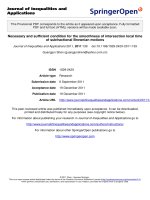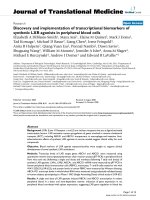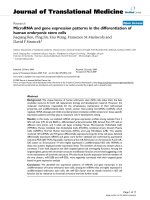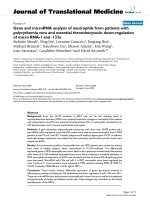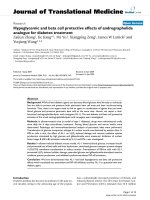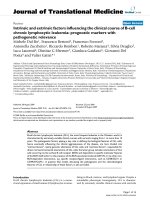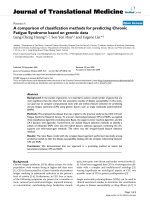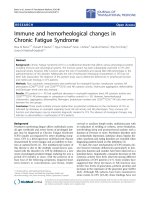báo cáo hóa học: "Exoskeletons and orthoses: classification, design challenges and future directions" ppt
Bạn đang xem bản rút gọn của tài liệu. Xem và tải ngay bản đầy đủ của tài liệu tại đây (592.23 KB, 9 trang )
BioMed Central
Page 1 of 9
(page number not for citation purposes)
Journal of NeuroEngineering and
Rehabilitation
Open Access
Commentary
Exoskeletons and orthoses: classification, design challenges and
future directions
Hugh Herr
1,2
Address:
1
MIT Media Lab, Massachusetts Institute of Technology, 20 Ames Street, Room 424, Cambridge, Massachusetts, USA and
2
MIT-Harvard
Division of Health Science and Technology, Massachusetts Institute of Technology, 20 Ames Street, Room 424, Cambridge, Massachusetts, USA
Email: Hugh Herr -
Abstract
For over a century, technologists and scientists have actively sought the development of
exoskeletons and orthoses designed to augment human economy, strength, and endurance. While
there are still many challenges associated with exoskeletal and orthotic design that have yet to be
perfected, the advances in the field have been truly impressive. In this commentary, I first classify
exoskeletons and orthoses into devices that act in series and in parallel to a human limb, providing
a few examples within each category. This classification is then followed by a discussion of major
design challenges and future research directions critical to the field of exoskeletons and orthoses.
Introduction
The current series of the Journal of NeuroEngineering and
Rehabilitation (JNER) is dedicated to recent advances in
robotic exoskeletons and powered orthoses. The articles
in this special issue cover a broad spectrum of embodi-
ments, from orthotic devices to assist individuals suffering
from limb pathology to limb exoskeletons designed to
augment normal, intact limb function.
To set the stage for this special issue, I classify exoskele-
tons and orthoses into four categories and provide design
examples within each of these. I discuss devices that act in
series with a human limb to increase limb length and dis-
placement, and devices that act in parallel with a human
limb to increase human locomotory economy, augment
joint strength, and increase endurance or strength. For
each exoskeletal type, I provide a design overview of hard-
ware, actuation, sensory, and control systems for a few
characteristic devices that have been described in the liter-
ature, and when available, describe the results of any
quantitative evaluation of the effectiveness of the devices
in performing their intended tasks. Finally, I end with a
discussion of the major design challenges that have yet to
be overcome, and possible future directions that may pro-
vide resolutions to these design difficulties.
For the purposes of this commentary, exoskeletons and
orthoses are defined as mechanical devices that are essen-
tially anthropomorphic in nature, are 'worn' by an opera-
tor and fit closely to the body, and work in concert with
the operator's movements. In general, the term 'exoskele-
ton' is used to describe a device that augments the per-
formance of an able-bodied wearer, whereas the term
'orthosis' is typically used to describe a device that is used
to assist a person with a limb pathology.
It is perhaps worth noting that the term "exoskeleton" has
come to describe systems that are comprised of more than
just a passive protective and supporting shell, as its usage
in biology would suggest. "Exoskeleton" within our
research community is taken to include mechanical struc-
tures, as well as associated actuators, visco-elastic compo-
nents, sensors and control elements.
Published: 18 June 2009
Journal of NeuroEngineering and Rehabilitation 2009, 6:21 doi:10.1186/1743-0003-6-21
Received: 11 May 2009
Accepted: 18 June 2009
This article is available from: />© 2009 Herr; licensee BioMed Central Ltd.
This is an Open Access article distributed under the terms of the Creative Commons Attribution License ( />),
which permits unrestricted use, distribution, and reproduction in any medium, provided the original work is properly cited.
Journal of NeuroEngineering and Rehabilitation 2009, 6:21 />Page 2 of 9
(page number not for citation purposes)
Series-limb exoskeletons
Elastic elements in the body, such as ligaments and ten-
dons, have long been known to play a critical role in the
economy and stability of movement [1-7]. Humans and
other animals use these tissues to reduce impact losses
while storing substantial quantities of energy when strik-
ing the ground, and to provide propulsion during termi-
nal stance in walking, running and jumping. Such
biological strategies have inspired designers of running
track surfaces and wearable devices such as shoes and
exoskeletons.
Previous studies have shown that a compliant running
track can improve performance by increasing running
speed by a few percent and may also reduce the risk of
injury [8]. In another study on elastic running surfaces,
the authors found a range of compliant ground surface
stiffnesses that improved metabolic running economy [9].
Similarly, previous studies have shown that wearable
mechanisms in series with the biological leg can reduce
the metabolic cost of running by lowering impact losses
and by providing energy return. A running shoe called the
Springbuck, designed with a carbon composite elastic
midsole, was shown to improve shock absorption and
metabolic economy at moderate running speeds (see Fig-
ure 1a); [10,11]. Although metabolic economy improved
when runners used this elastic shoe rather than a conven-
tional shoe design without an elastic midsole, the advan-
tage was found to be modest (~2%). Elastic exoskeletons
in series with the human leg have been developed that
store and release far greater strain energy than the running
track surface of [8] or the Springbuck shoe [10,11] (~5
Joules/step for track and shoe versus ~80 Joules/step for
elastic exoskeletons), and therefore it was believed that
such exoskeletons would augment human running speed
and economy. Notable inventions in this exoskeletal class
are the PowerSkip and the SpringWalker shown in Figure
1b and 1c, respectively
; [12].
However, although these devices clearly augment jump-
ing height, they have not been shown to improve peak
running speed nor running economy. In fact, in a study
conducted by the U.S. Army Research Institute of Environ-
mental Medicine (ARIEM) in Natick, Massachusetts, the
SpringWalker increased metabolic cost by 20% compared
to locomotion without the device [Personal Communica-
tion: Peter Frykman]. For this study, mass was added to
the subject's back equal to the SpringWalker mass.
Parallel-limb exoskeletons for load transfer
Here we discuss exoskeletons that act in parallel with the
human lower limb for load transfer to the ground. Per-
haps an in-series leg exoskeleton like the SpringWalker
Shoes and exoskeletons that act in series with the human lower limbFigure 1
Shoes and exoskeletons that act in series with the human lower limb. Examples are the Springbuck shoe [10,11], the
PowerSkip exoskeleton , and the SpringWalker exoskeleton [12] shown in 1a, 1b, and 1c, respec-
tively.
Journal of NeuroEngineering and Rehabilitation 2009, 6:21 />Page 3 of 9
(page number not for citation purposes)
(Figure 1c) increases the metabolic cost of running
because the limb length of the human plus machine is
substantially increased, thereby increasing both the work
at the hip to protract the leg during the aerial phase and
the overall energetic demand to stabilize movement, over-
coming any potential advantage of extending limb length.
Additionally, with an in-series leg exoskeleton device, the
ground reaction forces are still borne by the human leg. In
contrast, with a parallel mechanism, body weight could
be transferred through the exoskeleton directly to the
ground, decreasing the loads borne by the biological
limbs and lowering the metabolic demands to walk, run,
and hop. Furthermore, such a parallel exoskeleton would
not increase limb length, thereby not increasing the over-
all energetic demand to stabilize movement.
The earliest mention of such a parallel exoskeleton is a set
of United States patents granted in 1890 to Nicholas Yagn
[13,14]. His invention, shown in Figure 2a, comprises
long leaf springs operating in parallel to the legs, and was
intended to augment the running abilities of the Russian
Army. Each leg spring was designed to engage at foot strike
to effectively transfer the body's weight to the ground and
to reduce the forces borne by the stance leg during each
running stance period. During the aerial phase, the paral-
lel leg spring was designed to disengage in order to allow
the biological leg to freely flex and to enable the foot to
clear the ground. Although Yagn's mechanism was
designed to augment running, there is no record that the
device was ever built and successfully demonstrated.
The MIT Biomechatronics Group recently built an elastic
exoskeleton similar to Yagn's design. However, its
intended application was not for running augmentation,
but for lowering the metabolic demands of continuous
hopping [15,16]. The exoskeleton, shown in Figure 2b,
comprises fiberglass leaf springs that span the entire leg,
and is capable of transferring body weight directly to the
ground during the stance period. In distinction to Yagn's
exoskeleton, the MIT device does not include a clutch to
disengage the exoskeletal leaf spring during the aerial
phase since such a clutching control was deemed unnec-
essary for hopping. Without accounting for the added
weight of each exoskeleton, wearing the exoskeleton
reduced net metabolic power for continuous hopping by
an average of 24% compared to normal hopping [16].
When hoppers utilized external parallel springs, they
decreased the mechanical work performed by the legs and
substantially reduced metabolic demand compared to
hopping without wearing an exoskeleton. Since the bio-
mechanics of hopping are similar to that of running, it
seems plausible that the effects of wearing an exoskeleton
during hopping could predict the biomechanical and met-
abolic effects of wearing an exoskeleton during running,
and that substantial energetic advantages might be
achieved while running with a highly elastic, parallel leg
exoskeleton. Clearly, for the goal of augmenting human
running performance, lightweight and highly elastic leg
exoskeletons that act in parallel with the human leg pro-
vide a research area of critical importance.
Exoskeletons that act in parallel with the human lower limb for load transfer to the groundFigure 2
Exoskeletons that act in parallel with the human lower limb for load transfer to the ground. Examples are Yagn's
running aid [14], MIT's hopping exoskeleton [15,16], and Kazerooni's load-carrying exoskeleton [18,19] shown in 2a, 2b, and
2c, respectively.
Journal of NeuroEngineering and Rehabilitation 2009, 6:21 />Page 4 of 9
(page number not for citation purposes)
Parallel-limb exoskeletons have also been advanced to
augment the load-carrying capacity of humans [17-32].
This type of leg exoskeleton could benefit people who
engage in load carrying by increasing load capacity, less-
ening the likelihood of leg or back injury, improving met-
abolic locomotory economy, and/or reducing the
perceived level of difficulty. One such exoskeletal design
is shown in Figure 2c, or the Berkeley Lower Extremity
Exoskeleton (BLEEX) developed by Professor Kazerooni.
One of the distinguishing features of this exoskeleton is
that it is energetically autonomous, or carries its own
power source. Indeed, its developers claim it as the first
"load-bearing and energetically autonomous" exoskele-
ton [17].
BLEEX features three degrees of freedom (DOF) at the hip,
one at the knee, and three at the ankle. Of these, four are
actuated: hip flexion/extension, hip abduction/adduction,
knee flexion/extension, and ankle flexion/extension. Of the
non-actuated joints, the ankle inversion/eversion and hip
rotation joints are spring-loaded, and the ankle rotation
joint is free-spinning [18]. The kinematics and actuation
requirements of the exoskeleton were designed by assum-
ing behavior similar to that of a 75 kg human and utilizing
clinical gait analysis data for walking [18,19].
Interesting features of the kinematic design of the exoskel-
eton include a hip "rotation" joint that is shared between
the two legs of the exoskeleton, and therefore, does not
intersect with the wearer's hip joints. Similarly, the inver-
sion/eversion joint at the ankle is not co-located with the
human joint, but is set to the lateral side of the foot for
simplicity. The other five rotational DOF's of the exoskel-
eton coincide with the joints of the wearer [18].
The exoskeleton is actuated via bidirectional linear
hydraulic cylinders mounted in a triangular configuration
with the rotary joints, resulting in an effective moment
arm that varies with joint angle. BLEEX consumes an aver-
age of 1143 Watts of hydraulic power during level-ground
walking, as well as 200 Watts of electrical power for the
electronics and control. In contrast, a similarly sized, 75
kg human consumes approximately 165 W of metabolic
power during level-ground walking [18,19].
BLEEX was designed with linear hydraulic actuators since
they were the "smallest actuation option available" based
on their "high specific power (ratio of actuator power to
actuator weight)" [18]. However, a further study deter-
mined that electric motor actuation significantly
decreased power consumption during level walking in
comparison to hydraulic actuation [20]. The weight of the
implementation of the electrically-actuated joint, how-
ever, was approximately twice that of their hydraulically-
actuated joint (4.1 kg vs. 2.1 kg).
The control scheme of the BLEEX seeks to minimize the use
of sensory information from the human/exoskeleton
interaction, and instead, utilizes mainly sensory informa-
tion from the exoskeleton. Similarly to a bipedal robot,
the exoskeleton can balance on its own, but the human
wearer must provide a forward guiding force to direct the
system during walking. The control system utilizes the
information from eight encoders and sixteen linear accel-
erometers to determine angle, angular velocity, and angu-
lar acceleration of each of the eight actuated joints, a foot
switch, and load distribution sensor per foot to determine
ground contact and force distribution between the feet
during double stance, eight single-axis force sensors for
use in force control of each of the actuators, and an incli-
nometer to determine the orientation of the backpack
with respect to gravity [18].
In order to achieve their goal of being energetically auton-
omous with such an actuator selection, significant effort
was invested in developing a hybrid hydraulic-electric
portable power supply [21].
In terms of performance, users wearing BLEEX can report-
edly support a load of up to 75 kg while walking at 0.9 m/
s, and can walk at speeds of up to 1.3 m/s without the
load. A second generation of the Berkeley exoskeleton is
currently in testing. The new device is approximately half
the weight of the original exoskeleton (~14 kg [22]), in
part due to the implementation of electric actuation with
a hydraulic transmission system. A laboratory spin-off
company called Berkeley Bionics (Berkeley, CA) has been
formed in order to market the exoskeleton technology.
Parallel-limb exoskeletons for torque and work
augmentation
Here we discuss exoskeletons that act in parallel with the
human joint(s) for torque and work augmentation. Many
parallel-limb exoskeletons have been developed to aug-
ment joint torque and work [33-58]. In distinction to the
load-carrying exoskeletons mentioned in the last section,
this type of exoskeletal and orthotic device does not trans-
fer substantial load to the ground, but simply augments
joint torque and work. This type of leg exoskeleton could
improve walking and running metabolic economy, or
might be used to reduce joint pain or increase joint
strength in paralyzed or weak joints.
One such exoskeletal design is shown in Figure 3a. At the
University of Tsukuba in Japan, Professor Yoshiyuki
Sankai and his team have been developing an exoskeleton
concept that is targeted for both performance-augmenting
and rehabilitative purposes [49,50]. The leg structure of
the full-body HAL-5 exoskeleton powers the flexion/
extension joints at the hip and knee via a DC motor with
harmonic drive placed directly on the joints. The ankle
Journal of NeuroEngineering and Rehabilitation 2009, 6:21 />Page 5 of 9
(page number not for citation purposes)
flexion/extension degree of freedom is passive. The lower-
limb components interface with the wearer via a number
of connections: a special shoe with ground reaction force
sensors, harnesses on the calf and thigh, and a wide waist
belt.
The HAL-5 system utilizes a number of sensing modalities
for control: skin-surface EMG electrodes placed below the
hip and above the knee on both the anterior (front) and
posterior (back) sides of the wearer's body, potentiome-
ters for joint angle measurement, ground reaction force
sensors, a gyroscope and accelerometer mounted on the
backpack for torso posture estimation. These sensing
modalities are used in two control systems that together
determine user intent and operate the suit: an EMG-based
system and a walking pattern-based system. Reportedly, it
takes two months to optimally calibrate the exoskeleton
for a specific user [22].
HAL-5 is currently in the process of being readied for com-
mercialization. Modifications from previous versions
include upper-body limbs, lighter and more compact
power units, longer battery life (approximately 160 min-
utes continuous operating time), and a more cosmetic
shell. The total weight of the full-body device is 21 kg.
Cyberdyne (Tsukuba, Japan,
), a
company spun off from Sankai's lab, is responsible for the
commercialization of the product.
The ability of HAL to improve performance by increasing
the user's capacity to lift and press large loads has been
demonstrated
. An operator
wearing HAL can lift up to 40 kg more than they can man-
age unaided. Additionally, the device increases the user's
'leg press' capability from 100 to 180 kg. However, to date
no peer-reviewed, quantitative results have been pub-
lished highlighting the effectiveness of the exoskeleton's
lower-limb components for the improvement of locomo-
tory function.
A second example of a parallel-limb orthosis that aug-
ments joint torque and work is shown in Figure 3b. The
MIT Biomechatronics Group developed a powered ankle-
foot orthosis [52] to assist drop-foot gait, a deficit affect-
ing many persons who have experienced a stroke, or with
multiple sclerosis or cerebral palsy, among others. The
device consists of a modified passive ankle-foot orthosis
with the addition of a series elastic actuator (SEA) that is
controlled based on ground force and angle sensory infor-
mation. Using the SEA, the device varies the impedance of
the ankle during controlled plantar flexion in stance, and
assists with dorsiflexion during the swing phase of walk-
ing.
In clinical trials, the MIT active ankle-foot orthosis (AFO)
was shown to improve the gait of drop-foot patients by
increasing walking speed, reducing the instances of "foot
slap", creating better symmetry with the unaffected leg,
and providing assistance during powered plantar flexion.
Subjects' feedback was also favorable. The AFO is rela-
tively compact and consumes a small amount of power
(10W average electrical power consumption), and current
work at iWalk, LLC
, a spin-off
company from MIT, is focused on developing an energet-
ically autonomous, portable version of the device.
Parallel-limb exoskeletons that increase human endurance
Throughout the human body hundreds of muscles exert
forces to stiffen and move the limbs and torso. During
exhaustive exercise, only a small portion of these muscles
fatigue. For a repetitive anaerobic activity, a parallel-limb
exoskeleton could be designed to redistribute the cyclic
work load over a greater number of muscles for the pur-
pose of delaying the onset of fatigue. In such a strategy,
springs within the exoskeleton could be stretched by mus-
cles that would not normally fatigue if the exercise were
conducted without the mechanism. The energy stored by
the exoskeleton could then be used to assist those muscles
that would typically fatigue, possibly improving endur-
ance capacity.
To test whether it is indeed possible for an exoskeleton to
amplify endurance using this strategy, researchers [59]
conducted an experiment on six human subjects each
Exoskeletons that act in parallel with human joint(s) for torque and work augmentationFigure 3
Exoskeletons that act in parallel with human joint(s)
for torque and work augmentation. Examples are the
HAL 5 exoskeleton [49,50] and the MIT active ankle-foot
orthosis [52] shown in 3a and 3b, respectively.
Journal of NeuroEngineering and Rehabilitation 2009, 6:21 />Page 6 of 9
(page number not for citation purposes)
wearing a simple exoskeleton comprised of two springs
that connected each wrist to a waist harness (see Figure
4a). The springs were in equilibrium when both elbows
were fully flexed with the wrists positioned at chest height.
With this mechanism, a subject performed the following
cyclic activity until complete exhaustion using a given
spring stiffness. From a sitting position, a subject fully
extended his arms to grasp a pull-up bar directly overhead,
stretching the arm springs. With the assistance of the
stretched springs, the subject lifted his body upwards with
his arms until his chin cleared the bar. Then the subject
stood on the seat of a chair, released the bar, and sat down
on the chair. Note that the cycle did not include lowering
the body with the arms after pulling up. Using this
approach, energy was only stored in the springs by extend-
ing the arms upward. Each subject performed the experi-
ment five times with a given spring stiffness using a total
of five different spring stiffnesses. The order in which
spring stiffnesses were used was randomized to rule out
any sequential effects. In addition, each subject was
required to use the same time to sit down after pulling up
so that the time in which the arms were not being used
during each cycle did not change. Between experiments, a
subject was given two to three days of rest.
The experimental results are shown in Figure 4b. The
endurance was maximized around K ~0.25 for each sub-
ject. Further, the endurance with an exoskeleton increased
by 1.5-fold to 2.5-fold compared to the endurance when
no exoskeleton assist was employed. Using a mathemati-
cal model of the human arm and exoskeleton, researchers
[59] related overall muscle efficiency to exoskeletal stiff-
ness. The model predicted that muscle efficiency was max-
imized at the same dimensionless stiffness where
endurance reached its maximum (K~0.25 in Figure 4b),
suggesting that the endurance changes were a conse-
quence of changes in the efficiency with which the body
performed the required work for each cycle.
There are many applications for this class of exoskeleton.
For example, a crutch was constructed with an orthotic
elbow spring to maximize the endurance of physically-
challenged persons in climbing stairs and slopes [60].
When the crutch user flexes both elbows to place the
crutch tips onto the next stair tread, orthotic elbow springs
compress and store energy. This stored energy then assists
the crutch user during elbow extension, helping to lift the
body up the next step, and delaying the onset of bicep and
tricep muscle fatigue. In future developments, robotic
exoskeletons and powered orthoses could be put forth
that actively vary impedance to optimally redistribute the
body's work load over a greater muscle volume, maximiz-
ing the efficiency with which the body is able to perform
mechanical work and significantly augmenting human
endurance.
Design challenges and future directions
Although great progress has been made in the century-
long effort to design and implement robotic exoskeletons
and powered orthoses, many design challenges still
remain. Remarkably, a portable leg exoskeleton has yet to
be developed that demonstrates a significant decrease in
the metabolic demands of walking or running. Many
complicated devices have been developed that increase
consumption, such as the SpringWalker [12] and the MIT
load-carrying exoskeleton [27-29].
Exoskeletons that act in parallel with a human limb for endurance augmentationFigure 4
Exoskeletons that act in parallel with a human limb
for endurance augmentation. An example is the MIT
climbing exoskeleton [59] shown in 4a. As shown in 4b,
when the stiffness of the mechanism was optimally tuned,
endurance was increased from 1.5-fold to 2.5-fold across the
six human subjects evaluated. The mean number of cycles to
exhaustion ( ), or the endurance, normalized by the mean
value at zero stiffness ( ), is plotted in Fig. 4b versus the
dimensionless arm spring stiffness (K). K is defined as the
measured stiffness of the added spring (k) multiplied by the
maximum distance the spring was stretched (X
m
), and
divided by the subject's body weight (W). For each subject, a
cubic spline curve passes through the mean of the normal-
ized cycle values (± SE) at each of the five stiffness values.
Endurance is maximized around K ~0.25 for each subject.
N
N
o
Journal of NeuroEngineering and Rehabilitation 2009, 6:21 />Page 7 of 9
(page number not for citation purposes)
There are many factors that continue to limit the perform-
ance of exoskeletons and orthoses. Today's powered
devices are often heavy with limited torque and power,
making the wearer's movements difficult to augment.
Current devices are often both unnatural in shape and
noisy, factors that negatively influence device cosmesis.
Given current limitations in actuator technology, contin-
ued research and development in artificial muscle actua-
tors is of critical importance to the field of wearable
devices. Electroactive polymers have shown considerable
promise as artificial muscles, but technical challenges still
remain for their implementation [61,62]. These chal-
lenges include improving the actuator's durability and
lifetime at high levels of performance, scaling up the actu-
ator size to meet the force and stroke needs of exoskeletal/
orthotic devices, and advancing efficient and compact
driving electronics. Although difficulties remain, elec-
troactive polymer muscles may offer considerable advan-
tages to wearable robotic devices, allowing for integrated
joint impedance and motive force controllability, noise-
free operation, and anthropomorphic device morpholo-
gies. An improved understanding of muscle and tendon
function during human movement tasks may shed light
on how artificial muscles should ideally attach to the
exoskeletal frame (monoarticular vs. polyarticular actua-
tion) and be controlled to produce enhanced biomimetic
limb dynamics. For example, neuromechanical models
that capture the major features of human walking (e.g.
[63,64]) may improve understanding of musculoskeletal
morphology and neural control and lead to analogous
improvements in the design of economical, stable and
low-mass exoskeletons for human walking augmentation.
Another factor limiting today's exoskeletons and orthoses
is the lack of direct information exchange between the
human wearer's nervous system and the wearable device.
Continued advancements in neural technology will be of
critical importance to the field of wearable robotics.
Peripheral sensors placed inside muscle to measure the
electromyographic signal, or centrally-placed sensors into
the motor cortex, may be used to assess motor intent by
future exoskeletal control systems [65,66]. Neural
implants may have the potential to be used for sensory
feedback to the nerves or brain, thus allowing the exoskel-
etal wearer to have some form of kinetic and kinematic
sensory information from the wearable device [67].
Current exoskeletal/orthotic devices are also limited by
their mechanical interface. Today's interface designs often
cause discomfort to the wearer, limiting the length of time
that a device can be worn. It is certainly an achievable goal
to provide comfortable and effective mechanical inter-
faces with the human body. Contemporary external pros-
thetic limbs attach to the human body most commonly
via a prosthetic socket that is custom fabricated to an indi-
vidual's own contours and anatomical needs. Although
not a perfectly comfortable interface, today's prosthetic
sockets nonetheless allow amputee athletes to run mara-
thons, compete in the Ironman Triathlons, and even
climb Mount Everest. One strategy employed in the fabri-
cation of modern prostheses is to digitize the surface of
the residual limb, creating a three dimensional digital
description of the residual limb contours. Once the
amputee's limb has been scanned, their geometric data are
sent to a computer aided manufacturing (CAM) facility
where a new prosthetic socket is fabricated rapidly and at
relatively low cost.
In the future such file-to-factory rapid processes may be
employed for the design and construction of exoskeletal
and orthotic devices. In this framework, a three dimen-
sional scanning procedure would produce a digital record
of the human body's outer shape. This geometric data
along with other anatomical information, such as data on
tissue compliance and anatomically-sensitive areas,
would be combined with strength and endurance infor-
mation from a physical fitness diagnostic examination.
Such anatomical and fitness data, combined with the
wearer's augmentation requirements, would provide an
individual's design specification profile. An exoskeleton,
customized to fit the wearer's outer anatomical features
and physiological demands, would then be designed as a
'second skin'. Such a skin would be made compliant in
body regions having bony protuberances, and more rigid
in areas of high tissue compliance. The exoskeletal skin
would be so intimate with the human body that external
shear forces applied to the exoskeleton would not pro-
duce relative movement between the exoskeletal inner
surface and the wearer's own skin, eliminating skin sores
resulting from device rubbing. Compliant artificial mus-
cles, sensors, electronics and power supply would be
embedded within the three dimensional construct, offer-
ing full protection of these components from environ-
mental disturbances such as dust and moisture. Once
designed, device construction would unite additive and
subtractive fabrication processes to deposit materials with
varied properties (stiffness and density variations) across
the entire exoskeletal volume using large scale 3-D print-
ers and robotic arms.
Exoskeletons and the future of mobility
During the 20
th
century, investments in human-mobility
technology primarily focused on wheeled devices. Rela-
tively little investment was focused on the advancement
of anthropomorphic exoskeletal technologies that allow
humans to move bipedally at enhanced speeds and with
reduced effort and metabolic cost. It seems likely that in
the 21st century more investments will be made to drive
innovation in this important area. The fact that large auto-
mobile companies, such as Honda and Toyota, have
Journal of NeuroEngineering and Rehabilitation 2009, 6:21 />Page 8 of 9
(page number not for citation purposes)
recently begun exoskeletal research programs is an indica-
tion of this technological shift. Perhaps in the latter half of
this century, exoskeletons and orthoses will be as perva-
sive in society as wheeled vehicles are today. That would
allow the elderly, the physically challenged and persons
with normal intact physiologies to achieve a level of
mobility not yet achieved. That would be a day in which
the automobile – that large, metal box with four wheels –
is replaced with wearable, all-terrain exoskeletal devices,
allowing city streets to be transformed from 20
th
century
pavement to dirt, trees and rocks. One can only hope.
Competing interests
The author is founder of iWalk, LLC, a company dedicated
to the commercialization of wearable robotic technology
for human augmentation.
Acknowledgements
This work was supported in part by the MIT Media Lab Consortia.
References
1. Cavagna GA, Heglund NC, Taylor CR: Mechanical work in terres-
trial locomotion: two basic mechanisms for minimizing
energy expenditure. Am J Physiol 1977, 233:R243-R261.
2. Ker RF, Bennett MB, Bibby SR, Kester RC, Alexander RM: The
spring in the arch of the human foot. Nature 1987, 325:147-149.
3. Alexander RM: Elastic Mechanisms in Animal Movement Cambridge:
Cambridge University Press; 1988.
4. Blickhan R: The spring-mass model for running and hopping. J
Biomech 1989, 22:1217-1227.
5. McMahon TA, Cheng GC: The mechanics of running: how does
stiffness couple with speed? J Biomech 1990, 23(suppl 1):65-78.
6. Farley CT, Glasheen J, McMahon TA: Running springs: speed and
animal size. J Exp Biol 1993, 185:71-86.
7. Hogan N: Skeletal muscle impedance in the control of motor
actions. Journal of Mechanics in Medicine an Biology 2002,
2(3):359-373.
8. McMahon TA, Greene PR: The influence of track compliance on
running. J Biomech 1979, 12:893-904.
9. Kerdok AE, Biewener AA, McMahon TA, Weyand PG, Herr H: Ener-
getics and mechanics of human running on surfaces of differ-
ent stiffnesses. J Appl Physiol 2002, 92:469-478.
10. Herr H, Gamow RI: Shoe and foot prosthesis with bending
beam spring structures. U.S. Patent 5,701,686 1997.
11. Herr H, Gamow RI: Shoe and foot prosthesis with bending
beam spring structures. U.S. Patent 6,029,374 2000.
12. Dick J, Edwards E: Human Bipedal Locomotion Device. U.S. Pat-
ent 5,016,869 1991.
13. Yagn N: Apparatus for facilitating walking, running, and jump-
ing. U.S. Patent 420179 1890.
14. Yagn N: Apparatus for facilitating walking, running, and jump-
ing. U.S. Patent 438830 1890.
15. Herr H, Walsh C, Valiente A, Pasch K: Exoskeletons for running
and walking. U.S. Patent Application 60/736,929 2006.
16. Grabowski AM, Herr H: Leg exoskeleton reduces the meta-
bolic cost of human hopping. J Appl Physiol 2009 in press.
17. Kazerooni H, Steger R: The Berkeley lower extremity exoskel-
eton. Transactions of the ASME, Journal of Dynamic Systems, Measure-
ments, and Control 2006, 128:14-25.
18. Zoss AB, Kazerooni H, Chu A: Biomechanical design of the Ber-
keley lower extremity exoskeleton (BLEEX). IEEE ASME Trans
Mechatron 2006, 11(2):128-138.
19. Chu A, Kazerooni H, Zozz A: On the biomimetic design of the
berkeley lower extremity exoskeleton (BLEEX). Proc. of the
2006 IEEE International Conference on Robotics and Automation: Barce-
lona, Spain 2005:4345-4352.
20. Zoss A, Kazerooni H: Design of an electrically actuated lower
extremity exoskeleton. Advanced Robotics 2006, 20(9):967-988.
21. Amundson K, Raade J, Harding N, Kazerooni H: Hybrid hydraulic-
electric power unit for field and service robots. Proceedings of
the IEEE IRS/RSJ International Conference on Intelligent Robots and Sys-
tems: August 2–6, 2005; Alberta, Canada 2005:3453-3458.
22. Guizzo E, Goldstein H: The rise of the body bots. IEEE Spectrum
2005, 42(10):50-56.
23. Huang GT: Wearable robots. Technology Review 2004.
24. 2006 ARO in Review. U.S. Army Research Laboratory, U.S. Army
Research Office, Adelphi, MD; 2006.
25. Walsh CJ, Pasch K, Herr H: An autonomous, under-actuated
exoskeleton for load-carrying augmentation. Proc. IEEE/RSJ
International Conference on Intelligent Robots and Systems (IROS). Beijing,
China 2006:1410-1415.
26. Walsh CJ, Paluska D, Pasch K, Grand W, Valiente A, Herr H: Devel-
opment of a lightweight, underactuated exoskeleton for
load-carrying augmentation. Proc. IEEE International Conference on
Robotics and Automation. 2006; Orlando, FL, USA 2006:3485-3491.
27. Valiente A: Design of a quasi-passive parallel leg exoskeleton
to augment load carrying for walking. In Master's Thesis Massa-
chusetts Institute of Technology, Department of Mechanical Engi-
neering, MA, USA; 2005.
28. Walsh CJ: Biomimetic design of an underactuated leg
exoskeleton for load-carrying augmentation. In Master's Thesis
Massachusetts Institute of Technology, Department of Mechanical
Engineering, MA, USA; 2006.
29. Walsh C, Endo K, Herr H: A quasi-passive leg exoskeleton for
load-carrying augmentation. Int J HR 2007, 4(3):487-506.
30. Gregorczyk KN, Obusek JP, Hasselquist L, Schiffman JM, Bensel CK,
Gutekunst D, Frykman P: The Effects of a Lower Body Exoskel-
eton Load Carriage Assistive Device on Oxygen Consump-
tion and Kinematics during Walking with Loads. 25th Army
Science Conference. 2006; Orlando, FL, USA, Nov. 27–30 .
31. Jansen JF, Birdwell JF, Boynton AC, Crowell HP III, Durfee WK,
Gongola JD, Killough SM, Leo DJ, Lind RF, Love LJ, Mungiole M, Pin
FG, Richardson BS, Rowe JC, Velev OA, Zambrano T: Phase I
Report: DARPA Exoskeleton Program. Oak Ridge National Lab-
oratory Report number ORNL/TM-2003/216 2003.
32. Marks P: Power dressing. New Sci 2001.
33. Vukobratovic M, Hristic D, Stojiljkovic Z: Development of active
anthropomorphic exoskeletons. Med Biol Eng 1974,
12(1):66-80.
34. Vukobratovic M, Borovac B, Surla D, Stokic D: Scientific Fundamentals
of Robotics 7, Biped Locomotion: Dynamics Stability, Control, and Applica-
tion New York: Springer-Verlag; 1990.
35. Hristic D, Vukobratovic M, Timotijevic M: New model of autono-
mous 'active suit' for distrophic patients. Proceedings of the
International Symposium on External Control of Human Extremities
1981:33-42.
36. Grundmann J, Seireg A: Computer Control of Multi-Task
Exoskeleton for Paraplegics. Proceedings of the Second CISM/
IFTOMM International Symposium on the Theory and Practice of Robots
and Manipulators 1977:233-240.
37. Seireg A, Grundmann JG: Design of a Multitask Exoskeletal
Walking Device for Paraplegics. In Biomechanics of Medical
Devices Marcel Dekker, Inc, New York; 1981:569-644.
38. Tomovic R, Popovic D, Gracanin F: A technology for self-fitting
of orthoses. Proceedings of the International Symposium on External
Control of Human Extremities 1978:15-25.
39. Hristic D, Vukobratovic M, Gracanin F: Development and evalua-
tion of modular active orthosis. Proceedings of the International
Symposium on External Control of Human Extremities
1978:137-146.
40. Schwirtlich L, Kovacevic S, Popovic D: Clinical evaluation of the
self-fitting modular orthoses by spastic paraplegics. Proceed-
ings of the International Symposium on External Control of Human Extrem-
ities 1981:21-32.
41. Jaukovic ND: Active peroneal orthosis. Proceedings of the Interna-
tional Symposium on External Control of Human Extremities 1981:13-20.
42. Schwirtlich L, Popovic D: Hybrid orthoses for deficient locomo-
tion. Proceedings of the International Symposium on External Control of
Human Extremities 1984:23-32.
43. Popovic D, Schwirtlich L: Hybrid powered orthoses. Proceedings
of the International Symposium on External Control of Human Extremities
1987:95-104.
44. Popovic D, Schwirtlich L, Radosavijevic S: Powered hybrid assis-
tive system. Proceedings of the International Symposium on External
Control of Human Extremities 1990:177-186.
Publish with BioMed Central and every
scientist can read your work free of charge
"BioMed Central will be the most significant development for
disseminating the results of biomedical research in our lifetime."
Sir Paul Nurse, Cancer Research UK
Your research papers will be:
available free of charge to the entire biomedical community
peer reviewed and published immediately upon acceptance
cited in PubMed and archived on PubMed Central
yours — you keep the copyright
Submit your manuscript here:
/>BioMedcentral
Journal of NeuroEngineering and Rehabilitation 2009, 6:21 />Page 9 of 9
(page number not for citation purposes)
45. Durfee WK, Hausdorff JM: Regulating knee joint position by
combining electrical stimulation with a controllable friction
brake. Ann Biomed Eng 1990, 18:575-596.
46. Goldfarb M, Durfee WK: Design of a controlled brake orthosis
for FES-aided gait. IEEE Trans Rehabil Eng 1996, 4(1):13-24.
47. Yamamoto K, Hyodo K, Ishii M, Matsuo T: Development of power
assisting suit for assisting nurse labor. JSME International Journal.
Series C 2002, 45(3):703-711.
48. Yamamoto K, Ishii M, Hyodo K, Yoshimitsu T, Matsuo T: Develop-
ment of power assisting suit (miniaturization of supply sys-
tem to realize wearable suit). JSME International Journal Series C
2003, 46(3):923-930.
49. Kawamoto H, Sankai Y: Power assist system HAL-3 for gait dis-
order person. Lecture Notes on Computer Science (LNCS),
vol. 2398/2002. Proceedings of the International Conference on Comput-
ers Helping People with Special Needs (ICCHP), Berlin, Germany 2002.
50. Kawamoto H, Lee S, Kanbe S, Sankai Y: Power assist method for
HAL-3 using EMG-based feedback controller. Proceedings of
the IEEE International Conference on Systems, Man, and Cybernetics
2003:1648-1653.
51. Pratt JE, Krupp BT, Morse CJ, Collins SH: The RoboKnee: an
exoskeleton for enhancing strength and endurance during
walking. Proc. IEEE International Conference on Robotics and Automa-
tion, New Orleans, LA, USA 2004:2430-2435.
52. Blaya JA, Herr H: Control of a variable-impedance ankle-foot
orthosis to assist drop-foot gait. IEEE Trans Neural Syst Rehabil
Eng 2004, 12(1):24-31.
53. Ferris DP, Czerniecki JM, Hannaford B: An ankle-foot orthosis
powered by artificial muscles. J Appl Biomech 2005, 21:189-197.
54. Ferris DP, Gordon KE, Sawicki GS, Peethambaran A: An improved
powered ankle-foot orthosis using proportional myoelectric
control. Gait Posture 2006, 23:425-428.
55. Sawicki GS, Gordon KE, Ferris DP: Powered lower limb
orthoses: applications in motor adaptation and rehabilita-
tion. Proceedings of the 2005 IEEE International Conference on Rehabil-
itation Robotics (ICORR)
2005:206-211.
56. Nikitczuk J, Weinberg B, Mavroidis C: Rehabilitative knee ortho-
sis driven by electro-rheological fluid based actuators. Pro-
ceedings of the 2005 IEEE International Conference on Robotics and
Automation 2005:2283-2289.
57. Banala SK, Agrawal SK, Fattah A, Krishnamoorthy V, Hsu W, Scholz
J, Rudolph K: Gravity-balancing leg orthosis and its perform-
ance evaluation. IEEE Transactions on Robotics 2006,
22(6):1228-1239.
58. Kong K, Jeon D: Design and control of an exoskeleton for the
elderly and patients. IEEE Trans Neural Syst Rehabil Eng. 2006,
15(3):367-378.
59. Herr H, Langman N: Optimization of human-powered elastic
mechanisms for endurance amplification. Journal of the Interna-
tional Society for Structural and Multidisciplinary Optimization (ISSMO)
1997, 13:65-67.
60. Herr H: Crutch with Elbow and Shank Springs. US Patent
5,458,143 1995.
61. Herr H, Kornbluh R: New horizons for orthotic and prosthetic
technology: artificial muscle for ambulation. Smart Structures
and Materials 2004: Electroactive Polymer Actuators and Devices (EAPAD):
San Diego, CA 2004, 5385(1):1-9.
62. Mulgaonkar A, Kornbluh R, Herr H: A new frontier for orthotics
and prosthetics: application of dielectric elastomer actua-
tors to bionics. In Dielectric Elastomers as Electromechanical Transduc-
ers: Fundamentals, Materials, Devices, Models and Applications of an
Emerging Electroactive Polymer Technology Edited by: Carpi F, De Rossi
D, Kornbluh R, Pelrine R, Sommer-Larsen P. Elsevier; 2008.
63. Endo K, Paluska D, Herr H: A quasi-passive model of human leg
function in level-ground walking. Proc. IEEE/RSJ International Con-
ference on Intelligent Robots and Systems (IROS). 2006; Beijing, China
2006:4935-4939.
64. Geyer H, Herr H: A muscle-reflex model that encodes princi-
ples of legged mechanics predicts human walking dynamics
and muscle activities. IEEE Trans Neural Syst Rehabil Eng 2009 in
press.
65. Loeb GE: Neural prosthetics. In The Handbook of Brain Theory and
Neural Networks 2nd edition. Edited by: Arbib MA. Cambridge, Massa-
chusetts: MIT Press .
66. Truccolo W, Friehs GM, Donoghue JP, Hochberg LR: Primary
motor cortex tuning to intended movement kinematics in
humans with tetraplegia. J Neurosci 2008,
28(5):1163-1178.
67. Kuiken T, Li G, Lock BA, Lipschutz RD, Miller LA, Stubblefield KA,
Englehart KB: Targeted muscle reinnervation for real-time
myoelectric control of multifunction artificial arms. JAMA
2009, 301(6):619-628.
